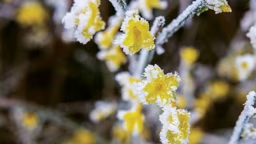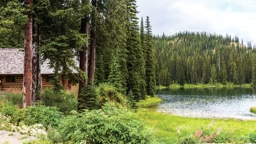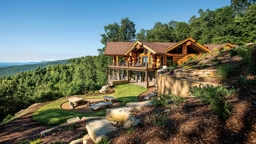
Even if your log home’s landscape boasts that slightly overgrown, English-garden look, it’s likely you’ll have to address pruning at some point. Bushes can get, well, bushy; and well-established trees can benefit greatly from some occasional maintenance, especially if branches start to block paths or threaten power lines.
Simply using pruning shears or a hedge trimmer anytime you have a free moment isn’t an ideal tactic, though. For example, pruning in the middle of summer, particularly when a shrub or tree is blooming or lush with foliage, can cause disease or pest issues because it leaves it open to infection or infestation. A plant needs to “heal” from the cuts.
Follow these tips for when to prune, along with other strategies to keep your trees and shrubs growing strong:
Trim trees and prune shrubs and bushes in late winter.
This means usually around March or April — just before spring warmth causes the plants to bud. This timing works because they’ll still be dormant, and that makes it easier for them to heal from the cuts you make. Also, it’ll be easier for you to see where to prune since the leaves will be gone.
One exception to the late-winter rule is a tree or shrub that blooms in the spring (as opposed to summer blooms), which should be pruned immediately after blooming. Shrubs that bloom in summer and fall should be pruned in early spring, before growth starts.
Keeping foliage away from your log walls is imperative, too.
Ideally, you should trim bushes at least 3 feet from the logs to allow air to circulate and to keep moisture away from the wood.
If any branches are dead or diseased, they can be removed anytime, even in the middle of summer.
Performing this regular maintenance is a good idea so that storms don’t bring those branches down onto your house, deck or healthy plants.
See Also: How to Create an Outdoor Landscape
For most shrubs and trees, pruning should fit the natural shape of the plant.
Well, that is unless you’re going for a highly formal, Palace of Versailles kind of look. The main purpose is to get rid of sucker branches that don’t appear to belong to the plant, weakened branches, sprouts coming up from the ground and overlapping branches that rub together.
After using your tools—like hedge clippers, pruning saws or small pruners — clean and disinfect the blades between plants.
This helps prevent the spread of plant diseases. Household disinfectants like Lysol or Pine-Sol have been found to be the least corrosive and most effective options for home gardeners. Cut with care! In most cases, the time to prune trees and shrubs is in late winter, just before the budding season. This allows the cuts you make to heal and prevents disease.
In general, consider pruning to be the kickoff to your gardening season, done just around the time you’re looking through seed catalogs and considering spring landscaping options. By the time you’re back in action with planting, mulching, fertilizing and luxuriating in your efforts, your trees and shrubs will be budding — and made stronger from their annual pruning.











